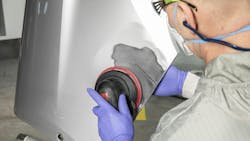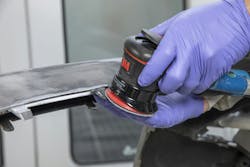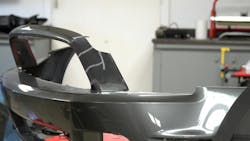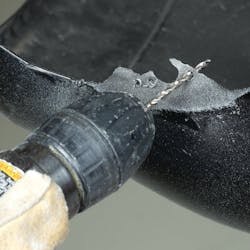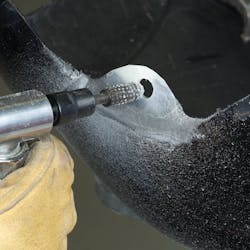Review the following two repair scenarios and select the one that best describes your operation.
Scenario one: A vehicle is brought into your shop with front-end damage, including some tears in the plastic bumper cover. Your estimator puts in a parts order for a new cover, which your techs later install and paint.
Scenario two: A vehicle is brought into your shop with front-end damage, including some tears in the plastic bumper cover. Your estimator recommends a nitrogen-welding repair to the plastic, which one of your techs performs.
In both cases, you’re looking at a relatively simple, quick repair. But there is a critical difference in cost and convenience. In scenario one, you’re spending money on a part, with most of that cost going to a vendor, and not your shop. In the second, costs are lower, and that money goes directly into your pocket while saving both your customers and insurers some significant cost.
Why isn’t scenario two the standard for the industry? Plastic repair experts say too many shops stick with the replacement option because they either gave up too early on plastic repairs or they believe this work is too specialized for their businesses. Don’t let these views affect your shop’s plastic repair journey. Use these five points, submitted by repair experts, to guide your way into adopting this accessible, revenue-generating work.
Point 1: You can do it.
John Wilburn, chief plastic welding instructor at Polyvance, says he’s visited a number of shops that eschew plastic repair for various reasons. “You see plastic welding equipment pushed into a corner because someone at the shop tried some repairs and maybe didn’t like the results, and the shop simply gave up,” he says. That’s unfortunate because with the right investment of time and training, practically every shop can do the work, which involves using prep products and tools, plastic adhesives, nitrogen welders and plastic welding bits to fix tears, holes and other damage.
Moreover, the work matches up well with metal welding. As with metal work, Wilburn says learning plastic repairs begins with technicians using basic skills then ramping off those with experience to build technical acuity. Shops should have plenty of opportunities to build skills (and revenue) considering the number of plastic parts that can be repaired, including fender liners, radiator overflow tanks, interior pieces, and many more.
Point 2: Training is readily available.
Getting started with plastic repair and honing skills should not be an issue since training is available through Polyvance, I-CAR, and 3M, among others. Wilburn notes that Polyvance houses training videos and information online, including step-by-step content on starting, maintaining and using welders to perform basic repairs. More advanced courses offered through 3M and Polyvance count toward I-CAR certification. Wilburn recommends estimators attend training sessions, so they’re better prepared to include plastic repairs on a work order.
Point 3: Technology is making plastic repair work easier.
Some new products are taking some of the biggest challenges out of this work, the first being the proper identification of the plastic type being repaired. A common misconception among repairers is that the color of a plastic can be used for identification. Wilburn points out plastic is actually identified by a symbol stamped on the part used to match it to the correct welding rod. From there, the technician refers to an instruction guide or chart to properly set up the welder for the specific plastic type. Polyvance recently introduced its Nitro-Fuzer Touch with Tru-Fuze Technology, which features preprogrammed settings for over 20 of the most common plastic types. This eliminates the need to determine optimal temperature and flow settings, which saves time and ensures accuracy.
Point 4: The plastic repair landscape doesn’t change much.
When delving into any unexplored, or relatively unexplored, technology, shops face the prospect of investing in technology that regularly demands continual outlays of new money. Both Wilburn and Shawn Collins, advanced application engineer at 3M, say this hasn’t been the case with plastic repair, as this work has remained relatively unchanged for at least the last 20 years. “We can’t predict what auto manufacturers will do in the future, but this area has seen very little change in the time I’ve been involved,” Wilburn says. Collins notes that he, too, has seen little change in the part of the repair landscape, with previous projections of plastic being replaced with other materials like carbon fiber never materializing (mainly due to costs). Both note that plastic welding techniques haven’t changed much, either.
All this adds up to a steady repair field, marked by upgrades in specific technology with no significant transformations in its foundations, that shouldn’t turn away any shop.
Point 5: You’ll need to stick with OEM guidelines.
Plastic repairs are not without a few significant developments. According to Collins, evolutions in automotive technology can affect either specific areas of the plastic part or its entirety that could restrict its repair. This, of course, has to do with the location of sensors and factors such as the depth of finishes. Collins says these challenges, more than ever, compel shops to consistently refer to OEM repair guidelines.
“The latest challenges are what you can repair. “Take Volkswagen,” he explains. “Restrictions for repairs to the front bumper cover are as follows: Do not exceed the maximum paint coat thickness of 150 microns in the area of the control modules or lane-change assistance. Plastic repair performed in this area in the vicinity with a minimum distance of 25 centimeters. Smoothing performed in the same area requires a minimum distance of 25 centimeters.”
Collins stresses that repair guidelines differ from one manufacturer and model to the next. “A Mazda bulletin on polypropylene bumper covers states that damaged bumper covers on models with blind spot monitoring must be replaced,” he says. “If the bumper around the BSM is damaged, Mazda says the bumper has to be replaced.”
Volvo provides guidelines that include images of bumpers with shaded areas indicating zones that can’t be repaired. Further, Volvo states that the products used on its bumper covers have undergone its very stringent requirements and quality tests since metallic particles in car paint can deflect and/or distort radar beam energy being transmitted through the layers. Repairers are instructed to minimize the total thickness of existing metallic paint and any coatings before applying new layers, so there won’t be excessive film build.
(NOTE: Please refer to full guidelines provided by each manufacturer.)
As with much repair information, you may need to do some digging to find full instructions. Collins notes that OEMs continue working hard to provide accurate repair steps, but shops need to remain diligent to seek out this information. This fact shouldn’t scare off shops from plastic work since it’s true for any other part of a repair.
Companies like Polyvance and 3M do provide support, but both Wilburn and Collins caution that they can only provide information on their products, not on specific repairs. But this product information and the SOPs for using it are “bulletproof,” says Collins.
That’s one less worry for shops. Making this work less worrisome is the goal of plastic repair experts. Whether you’ve never attempted plastic repairs or perhaps gave up on them at some point, now might be a good time to speak with vendors and reassess these decisions. Your shop has the skills. The equipment and training are available. Your future is what you make of it.
About the Author

Tim Sramcik
Tim Sramcik began writing for ABRN over 20 years ago. He has produced numerous news, technical and feature articles covering virtually every aspect of the collision repair market. In 2004, the American Society of Business Publication Editors recognized his work with two awards. Sramcik also has written extensively for Motor Age and Aftermarket Business World. Connect with Sramcik on LinkedIn and see more of his work on Muck Rack.
